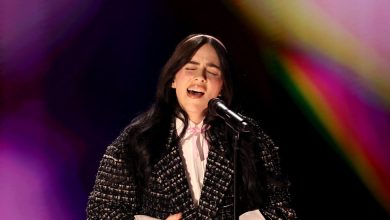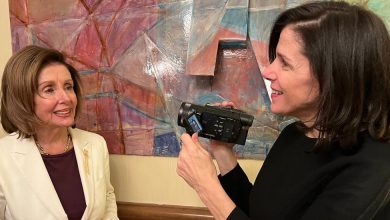Maggie Rogers’s Higher Calling


“I wanted to build a framework for myself, for how to keep art sacred,” Maggie Rogers said of her detour to Harvard Divinity School during the pandemic.Credit…OK McCausland for The New York Times
Like a lot of artists during the early days of the pandemic, Maggie Rogers was living a sequestered, solitary life. She had retreated to coastal Maine, trying to alleviate the burnout of touring for her 2019 major-label debut “Heard It In a Past Life,” with little plan to write. “I was hiding out,” she said. “At a complete loss for words.”
But Rogers, who had earned a Grammy nomination for best new artist with that album, which merged her folky singer-songwriter roots with dance-tent momentum, didn’t stay cloistered for long. Remembering that “making beats is fun,” she joined a virtual song-a-day accountability group with the likes of Feist, Damien Rice and Mac DeMarco. “I would go for a walk and then listen to all my favorite artists make some [expletive] in our kitchens,” she said. “It was so sick.” The demos she produced in her own home studio sounded joyful, which surprised her.
She thought the tumult and rage of the moment would lead her elsewhere. And then it did.
“I talk so much about the artist’s job being to feel,” she said recently. “Feeling through the last couple of years — there’s been so much pain and so much suffering and so much injustice in the world. It brought up a lot of questions for me about what I believe, and how I want to structure my artistic practice or my business. Or my life.”
So Rogers, while she was busy concocting sick beats in her kitchen, enrolled in Harvard Divinity School. “I wanted to build a framework for myself, for how to keep art sacred,” she said.
She graduated in May with a master’s degree in religion and public life, a new program for mostly secular professionals “whose work is focused on having a positive social impact,” according to the university. In Rogers’s case, it included her struttingly confident performance at Coachella this past spring. “I feel super religious, if music is a religion,” she said. “When I’m in the crowd of fans or onstage, that’s when I felt the most connected to something greater than myself.”
As she was studying, she was also completing “Surrender,” her second album for Capitol, a hypnotically danceable ode to ecstatic abandon, making leaps and navigating worry. Produced by Kid Harpoon (Harry Styles, Florence + the Machine) and embracing distortion — a new sound for her — it’s due out Friday.
“Right now, the joy on the record feels like the greatest form of rebellion,” Rogers, 28, said. It’s a hard-won hope, which — politically, culturally, environmentally — might be the vibe of the moment. “Surrender” was also part of her thesis, which examined cultural consciousness, the spirituality of public gathering and the ethics of pop power. The album, she told me, is “joy with teeth.”
Terry Tempest Williams, an essayist, naturalist and a visiting professor at Harvard Divinity School, taught Rogers in a class called “Finding Beauty in a Broken World.” Her fans may know her as “a rock star,” Williams wrote in an email. “But I know her as a writer. Her words are lean, staccato, unadorned, visceral. She writes through the full range of emotion that she inhabits. ”
Williams added that Rogers “is mindful of the responsibility that comes especially as a musician with a large stage.”
“The bridge between a public life and private life is stillness, having time to remember who you are and who you are not,” Williams wrote. “She dances between motion and stillness.”
On a drizzly June weekday, Rogers and I met at an Upper East Side corner diner, to wait out the rain before making a pilgrimage to one of her sacred spots in the city, Bethesda Fountain in Central Park. She wore a chopped-off white undershirt, a cozy black thrifted sweater (all hail the Portland, Maine, Goodwill) and her once long, Laurel Canyon songwriter-esque hair shorn into a pixie — a development that was covered by Teen Vogue, though she’s sported that cut for most of her life. An angular Ferragamo mini-purse and square metal-capped boots were the only hints ofmajor label star.
Freckle-faced and warm, she was eloquent about her musical choices, with an undercurrent of goofball (like when she shoved a tampon up her nose to stanch a nosebleed while dancing at Coachella — and then used the video clip to advertise her set).
Rogers had just moved out of her grad school apartment in Cambridge, Mass., a few weeks before — “my hot take on Boston: great food, bad lighting” — and was still determining where she would set up her new artistic life. “I feel like I’m in post-grad for the next year or something,” she said. “I’m doing field research.”
She grew up in rural Easton, Md.; the Los Angeles apartment where she now stores her stuff has never quite felt like home. While she was an undergraduate at New York University studying music production and engineering, her track “Alaska” drew a viral bit of adulation from Pharrell Williams, and she felt a pull to the city as the place where she learned “what kind of artist I wanted to be.” “Surrender” seemed to her like a punky New York album; she missed what she called “the raw human energy, and community — that claustrophobic, someone sweating on you in the subway” connectedness.
The video for the propulsive, synthy first single “That’s Where I Am,” with a bed of glitches and handclaps underneath Rogers’ clarion vocals about desire, pays tribute to that, as she catwalks through downtown Manhattan in a green boa, and piles into a cab with a New York crosscurrent — club kids and office workers. (The guitarist Hamilton Leithauser, the photographer Quil Lemons and David Byrne, who she cold-called to collaborate, show up too.)
Her musical process starts with making a mood board. “In production, I always think of records as world building — if I understand that, what the world is, it’s way easier for me to understand what the bass should sound like,” she said.
Kid Harpoon, the British producer, with whom she co-wrote her 2018 single “Light On,” remembered that the images for “Surrender” included black-and-white grittiness and ’70s New York — “Someone on their knees in a club with their top off, sweat all down them. Up-close teeth.” Rogers insisted on recording in the city too, a choice he didn’t necessarily understand until they set up shop last summer at Electric Lady, the storied West Village studio. “I’ve seen her just completely uncompromising on some of her ideas — quite brutally sometimes,” he said. “It’s a real strength. She knows what she wants.”
They used the location to bring in other musicians, like Florence Welch, who was upstairs recording with Jack Antonoff and played tambourine on the jagged power anthem “Shatter,” and Jon Batiste, who was “just reacting” with so much delight, Kid Harpoon said, that they sometimes had to reset the take for his keyboards because the Grammy-winning bandleader was laughing.
And Rogers, after years of performing — she had self-released two albums by the time she was 20 — found other shades in her own already protean vocals. “I learned how to use my lower register,” she said, “to just sing with my whole body.”
“Heard It in a Past Life” was suffused with nature samples; “Surrender” uses distortion, which Rogers had hardly worked with previously. But she found an audio plug-in and flew with it. “The world was collapsing and my life in Maine was incredibly quiet,” she said. “Noise felt so therapeutic.”
In a video introducing the album, she called it “chaos I could control.”
When the skies cleared, Rogers and I meandered to Bethesda Fountain. Along with St. Mark’s Church in the East Village — where Patti Smith had her first poetry-and-electric-guitar gig — it’s a place she often detours to, for inspiration. She was drawn in by its history, too: “Angel of the Waters,” the 8-foot tall bronze sculpture at the center of the fountain, was designed by Emma Stebbins, the first woman to be commissioned for a major public artwork in New York, and unveiled in 1873.
“This feels hopeful to me,” Rogers said, as tourists snapped pictures by the fountain and dozens of turtles dozed and lapped in the lake beyond. “The angel represents peace and temperance. She holds a lily. People still come here.”
Once she even saw Joan Didion, a hero, being wheeled around by an attendant for an afternoon constitutional. Rogers was too awed to approach her, but did notice she was sockless. “I remember seeing her ankles,” she said, “and being like, whoa, that’s so intimate.” Rogers has a fine radar for the vulnerable points; Didion, the master modernist writer, died not long after. “I might cry talking about it,” she said.
She is still working out how to apply what she learned in the last year to her creative life. But one way is just to pay close attention. “I always think about performance as a practice of presence,” she said. “It’s just this moment that is slipping through your fingers as it’s happening, and it can never be created again. And that’s what feels so sacred about it.”
The rain started up again, but she went without an umbrella — she liked the patter of the summer drops. The album’s closing song is full of fret about “the state of the world,” and Rogers sought out education to respond to that feeling. Her music gets her there too; the song ends on a wishful note — with banger percussion — about togetherness. “I think part of creating anything is having hope that there is something else that’s possible,” she said. “I feel like I don’t have any other choice.”





